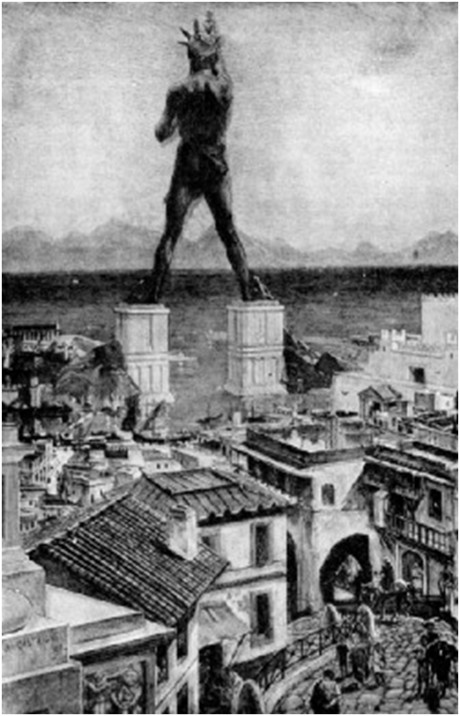
The Colossus of Rhodes, also known as the Colossus of Helios, was a 107 ft. (30 m.) statue of the Greco-Roman Sun God, Helios (Apollo). It was constructed to celebrate Rhodes’ victory in the Siege of Rhodes in 305 - 304 B. C. After Alexander the Great died, fighting had broken out between his generals. Rhodes sided with Ptolemy, and formed an alliance with Ptolemaic Egypt when Ptolemy took Egypt. Antigonus I Monophthalmus had his son Demetrius Poliorcetes invade Rhodes with an army 40,000 strong in 305 B. C. The city was well defended, and Demetrius had to build siege towers to invade. His first tower, which was placed on a ship, sank in a storm, and his second tower, which was land-based and called the Helepolis, was stopped when the Rhodians flooded the land in front of Rhodes. The next year, Ptolemy landed with a relief force, and Demetrius retreated. The Rhodians sold the equipment he had left behind in his haste for 300 talents ($360,000,000) and built the Colossus to celebrate.
It was built on top of a 50 ft. (15 m.) high white marble pedestal near the Mandraki harbor entrance (although some sources place it on a breakwater in the harbor), with iron bars with brass plates attached to form the skin. The interior was then filled with stone blocks. Most of the gold and bronze was salvaged from Demetrius’ army’s weapons and the Helepolis was used for scaffolding around the lower levels. The upper portions were built with a large earthen ramp and when the statue was completed in 280, the earth which had surrounded the statue was removed.
Modern engineers have attempted to reconstruct the construction methods used in the building of the Colossus. The base was at least 60 ft. (18 m.) high and was either circular or octagonal. The feet were carved in stone and covered with thin bronze plates. Eight iron bars formed the ankles. Individually cast bronze plates 60 in.2 (1,500 mm.)2 with turned-in edges were riveted together into rings. The lower plates were 1 in. (25 mm) thick to the knee and 3/4 in. (183/4 mm.) thick from the knee to the abdomen. The upper plates were 1/4 - 1/2 in. (61/4 - 121/2 mm.) thick except at the joints, where additional strength was required. The legs had to be filled with stone at least to the knee for stability. Modern engineers have proposed that instead of earthen ramps, which would have to be 300 ft. (91 m.) in diameter and would exceed the available land area, the abandoned siege towers, after being stripped down, would have made efficient scaffolding.
A computer simulation has shown that with these methods, an earthquake would have caused a cascade failure of the rivets, causing the statue to fall apart at the joints. The arms would have separated first, followed by the legs. The knees were less likely to break and the ankles would depend on the workmanship. The statue was destroyed by an earthquake in 226 B. C. Ptolemy III offered to rebuild the statue, but the oracle of Delphi made the Rhodians believe that they had offended Helios, and they declined. The remains lay on the ground for over 800 years, and many travelled to see them. In 654 Rhodes was captured by the Umayyad caliph and Sahabi of Muhammad Muawiyah I. A story circulated that the Arabs dismantled the remains and sold them to a Jewish merchant from Edessa, but it is likely that they were missing long before.